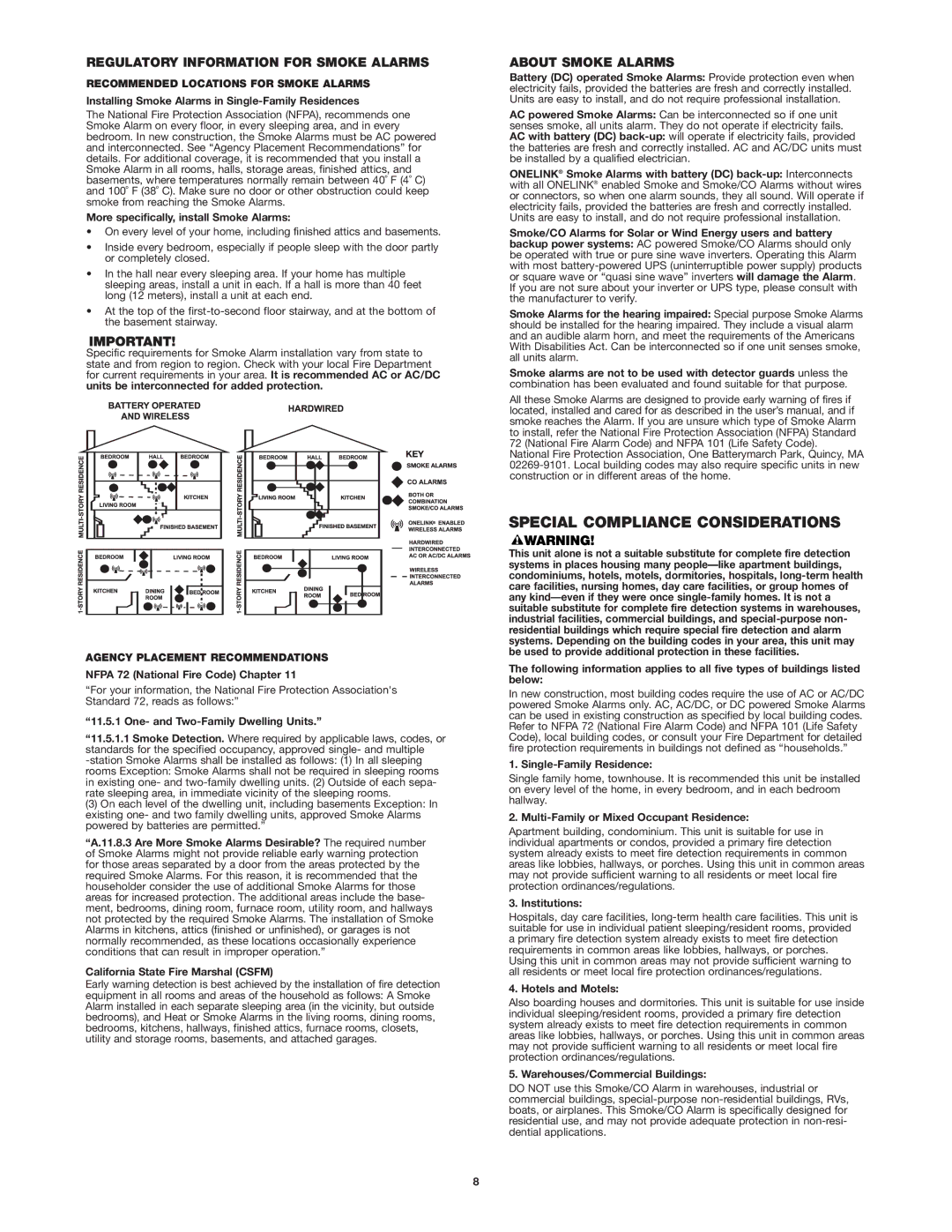
REGULATORY INFORMATION FOR SMOKE ALARMS
RECOMMENDED LOCATIONS FOR SMOKE ALARMS
Installing Smoke Alarms in Single-Family Residences
The National Fire Protection Association (NFPA), recommends one Smoke Alarm on every floor, in every sleeping area, and in every bedroom. In new construction, the Smoke Alarms must be AC powered and interconnected. See “Agency Placement Recommendations” for details. For additional coverage, it is recommended that you install a Smoke Alarm in all rooms, halls, storage areas, finished attics, and basements, where temperatures normally remain between 40˚ F (4˚ C) and 100˚ F (38˚ C). Make sure no door or other obstruction could keep smoke from reaching the Smoke Alarms.
More specifically, install Smoke Alarms:
•On every level of your home, including finished attics and basements.
•Inside every bedroom, especially if people sleep with the door partly or completely closed.
•In the hall near every sleeping area. If your home has multiple sleeping areas, install a unit in each. If a hall is more than 40 feet long (12 meters), install a unit at each end.
•At the top of the
Specific requirements for Smoke Alarm installation vary from state to state and from region to region. Check with your local Fire Department for current requirements in your area. It is recommended AC or AC/DC units be interconnected for added protection.
AGENCY PLACEMENT RECOMMENDATIONS
NFPA 72 (National Fire Code) Chapter 11
“For your information, the National Fire Protection Association's Standard 72, reads as follows:”
“11.5.1 One- and Two-Family Dwelling Units.”
“11.5.1.1 Smoke Detection. Where required by applicable laws, codes, or standards for the specified occupancy, approved single- and multiple
(3)On each level of the dwelling unit, including basements Exception: In existing one- and two family dwelling units, approved Smoke Alarms powered by batteries are permitted.”
“A.11.8.3 Are More Smoke Alarms Desirable? The required number of Smoke Alarms might not provide reliable early warning protection for those areas separated by a door from the areas protected by the required Smoke Alarms. For this reason, it is recommended that the householder consider the use of additional Smoke Alarms for those areas for increased protection. The additional areas include the base- ment, bedrooms, dining room, furnace room, utility room, and hallways not protected by the required Smoke Alarms. The installation of Smoke Alarms in kitchens, attics (finished or unfinished), or garages is not normally recommended, as these locations occasionally experience conditions that can result in improper operation.”
California State Fire Marshal (CSFM)
Early warning detection is best achieved by the installation of fire detection equipment in all rooms and areas of the household as follows: A Smoke Alarm installed in each separate sleeping area (in the vicinity, but outside bedrooms), and Heat or Smoke Alarms in the living rooms, dining rooms, bedrooms, kitchens, hallways, finished attics, furnace rooms, closets, utility and storage rooms, basements, and attached garages.
ABOUT SMOKE ALARMS
Battery (DC) operated Smoke Alarms: Provide protection even when electricity fails, provided the batteries are fresh and correctly installed. Units are easy to install, and do not require professional installation.
AC powered Smoke Alarms: Can be interconnected so if one unit senses smoke, all units alarm. They do not operate if electricity fails. AC with battery (DC)
ONELINK® Smoke Alarms with battery (DC)
Smoke/CO Alarms for Solar or Wind Energy users and battery backup power systems: AC powered Smoke/CO Alarms should only be operated with true or pure sine wave inverters. Operating this Alarm with most
Smoke Alarms for the hearing impaired: Special purpose Smoke Alarms should be installed for the hearing impaired. They include a visual alarm and an audible alarm horn, and meet the requirements of the Americans With Disabilities Act. Can be interconnected so if one unit senses smoke, all units alarm.
Smoke alarms are not to be used with detector guards unless the combination has been evaluated and found suitable for that purpose.
All these Smoke Alarms are designed to provide early warning of fires if located, installed and cared for as described in the user’s manual, and if smoke reaches the Alarm. If you are unsure which type of Smoke Alarm to install, refer the National Fire Protection Association (NFPA) Standard 72 (National Fire Alarm Code) and NFPA 101 (Life Safety Code).
National Fire Protection Association, One Batterymarch Park, Quincy, MA
SPECIAL COMPLIANCE CONSIDERATIONS
This unit alone is not a suitable substitute for complete fire detection systems in places housing many
The following information applies to all five types of buildings listed below:
In new construction, most building codes require the use of AC or AC/DC powered Smoke Alarms only. AC, AC/DC, or DC powered Smoke Alarms can be used in existing construction as specified by local building codes. Refer to NFPA 72 (National Fire Alarm Code) and NFPA 101 (Life Safety Code), local building codes, or consult your Fire Department for detailed fire protection requirements in buildings not defined as “households.”
1. Single-Family Residence:
Single family home, townhouse. It is recommended this unit be installed on every level of the home, in every bedroom, and in each bedroom hallway.
2. Multi-Family or Mixed Occupant Residence:
Apartment building, condominium. This unit is suitable for use in individual apartments or condos, provided a primary fire detection system already exists to meet fire detection requirements in common areas like lobbies, hallways, or porches. Using this unit in common areas may not provide sufficient warning to all residents or meet local fire protection ordinances/regulations.
3. Institutions:
Hospitals, day care facilities,
4. Hotels and Motels:
Also boarding houses and dormitories. This unit is suitable for use inside individual sleeping/resident rooms, provided a primary fire detection system already exists to meet fire detection requirements in common areas like lobbies, hallways, or porches. Using this unit in common areas may not provide sufficient warning to all residents or meet local fire protection ordinances/regulations.
5. Warehouses/Commercial Buildings:
DO NOT use this Smoke/CO Alarm in warehouses, industrial or commercial buildings,
8
